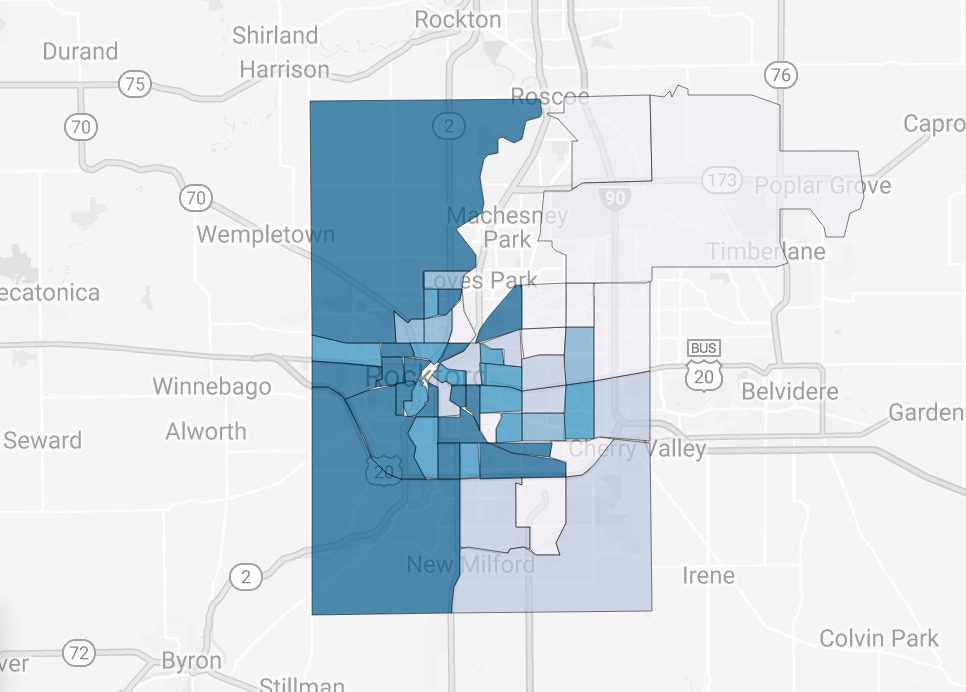Rockford, IL

Engaging in EDI
When the community set on a journey to transform Rockford in 2013, residents joined in a call-to-action for improving the living and working conditions in our region. In October 2017, the community established a partnership with Tamarack Institute, an internationally recognized program that develops and supports strategies that engage local people to solve major issues in their own community. Thanks to the Collective Impact Support team, led by Northern Illinois Center for Non-Profit Excellence, and the support of several local businesses and foundations, Tamarack hosted a workshop to help the community identify a significant complex social issue in the area to solve and agreed to align around 3rd-grade literacy as a keystone outcome for student success. However, 3rd-grade literacy was only one aspect of a much bigger picture. More information on child development was needed in order to identify the best supports and resources that will help prepare children to enter school.
In June 2018, using the Data Walk best practice tool, stakeholders teamed-up to create a deeper, shared understanding of the issue and began building a common agenda to achieve this key educational milestone. Implementing the Early Development Instrument (EDI) allows Transform Rockford, Alignment Rockford, Rockford Public School District 205 as well as private schools to take a community-wide, neighborhood-level look at achieving readiness for all.
Naming the Neighborhoods
Written by the EDI Champions of Rockford
The Rockford Pilot Team (Pilot Team) for the EDI project, which consists of members from the community, met several times over the course of a six-month period to determine how we could best organize, communicate, and present data to our community in a way that could be easily referenced, understood, and discussed. Part of this process included identifying neighborhood names.
A subset of the Pilot Team met with neighborhood leaders at the beginning of this exercise to determine what level of neighborhood involvement would be important for this process. We learned that the Great Neighborhoods Initiative, in partnership with many community organizations, has already been working with neighborhoods to identify neighborhood boundaries and identity, and many already have names. Rather than having neighborhood leaders go through the same exercise again, we used community maps that were already available to plug in names that have already been established.
To honor the great work that our neighborhoods have already done in identifying their own names, we stayed true to those names. When there were two or more neighborhoods in a single census tract, neighborhood names were combined. When a neighborhood overlapped into multiple census tracts, directional descriptors were added like “East” and “West.” When we could not find a neighborhood name on any of our maps, common geographic reference points like a creek or a park were used to identify the neighborhood. School names were not used to identify a neighborhood because the EDI is meant to situate children within the context of their neighborhood and inspire broader, community-wide responsibility for addressing vulnerability.
A few neighborhoods overlap perfectly with census tracts and have long-established names. This includes Edgewater, Signal Hill, Churchill’s Grove, and North End Square. Other neighborhoods were easy to name when we looked at existing neighborhood associations, or asked residents. It included neighborhoods like Washington Park, Forest Hills, Spice, ORCHiD, South Gate, Orton Keyes, and St. Elizabeth. Also easy to name were “combination” tracts like Haight Village/Midtown, Brown Hill/Rural Oaks, and Prairie Hill/Jackson Prairie, and “divided” tracts like Ellis Heights East and Ellis Heights West, and Rolling Green East and Rolling Great West.
Once children were geocoded to the map, the Pilot Team was then able to determine if preliminary neighborhood boundaries in each area met the minimum threshold of at least 10 students. In some neighborhoods, it made sense to combine two census tracts. Alternatively, in areas of the city that are growing with residents, the decision was made to suppress the data so that changes in those census tracts can be tracked over time in the future.
Community Data Sources
To download a PDF of the metadata document for the City of Rockford's EDI implementation during the 2018-2019 school year, click here.
Community Contact
For more information on local resources, contact:
Esther Lodge, Program Manager (Ready to Learn)
779-774-4389
esther@alignmentrockford.com